中国传统书法英文介绍
向外国人介绍书法艺术的英语作文
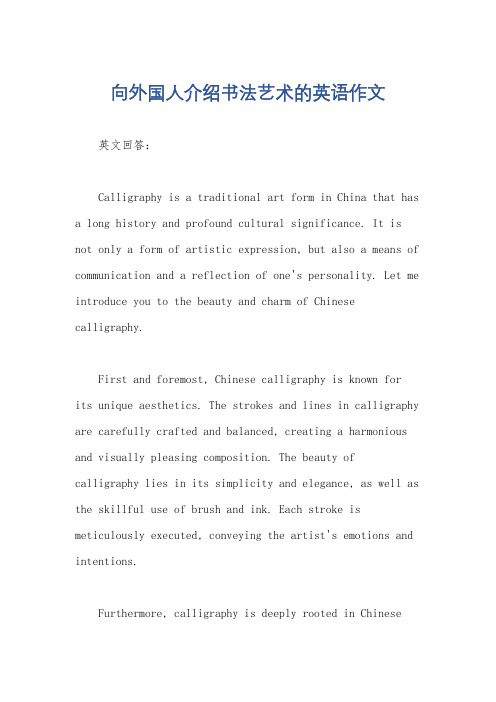
向外国人介绍书法艺术的英语作文英文回答:Calligraphy is a traditional art form in China that has a long history and profound cultural significance. It is not only a form of artistic expression, but also a means of communication and a reflection of one's personality. Let me introduce you to the beauty and charm of Chinese calligraphy.First and foremost, Chinese calligraphy is known forits unique aesthetics. The strokes and lines in calligraphy are carefully crafted and balanced, creating a harmonious and visually pleasing composition. The beauty ofcalligraphy lies in its simplicity and elegance, as well as the skillful use of brush and ink. Each stroke is meticulously executed, conveying the artist's emotions and intentions.Furthermore, calligraphy is deeply rooted in Chineseculture and has played a significant role in shaping the Chinese language. Chinese characters are composed of various strokes, and calligraphy helps to preserve and promote the correct form and structure of these characters. Through calligraphy, one can gain a deeper understanding of the Chinese language and its rich cultural heritage.Moreover, calligraphy is not only an art form, but also a way to cultivate one's character and inner self. The practice of calligraphy requires patience, discipline, and concentration. It is a meditative process that allows the artist to focus their mind and express their thoughts and emotions. By practicing calligraphy, one can develop a sense of tranquility and inner peace.In addition, calligraphy is a form of cultural exchange and appreciation. It has gained popularity and recognition worldwide, attracting people from different countries and backgrounds. Many foreign artists have also been inspired by Chinese calligraphy and incorporated its elements into their own artistic creations. This cultural exchange not only promotes mutual understanding and respect, but alsoenriches the diversity of artistic expression.In conclusion, Chinese calligraphy is a unique and profound art form that encompasses aesthetics, culture, and personal development. Its beauty lies in its simplicity and elegance, while its cultural significance lies in its preservation of the Chinese language and heritage. Through calligraphy, one can not only appreciate the artistic beauty, but also cultivate one's character and engage in cultural exchange. Chinese calligraphy truly embodies the essence of Chinese culture.中文回答:书法是中国的一种传统艺术形式,具有悠久的历史和深厚的文化意义。
用英语介绍中国书法包括书法的意义和作用

用英语介绍中国书法包括书法的意义和作用Chinese Calligraphy and Its SignificanceIntroduction:China, known as the birthplace of paper and ink, has a long and rich history of calligraphy. Chinese calligraphy is a unique art form that holds immense cultural significance. In this article, we will explore the meaning and purpose of calligraphy in China.Definition and Styles:Chinese calligraphy, known as Shūfǎ (书法) in Mandarin, is the artistic expression of writing Chinese characters. It combines both the written word and visual art. With a history of over 3,000 years, Chinese calligraphy has evolved into several distinct styles, including the seal script (篆书), the clerical script (隶书), the regular script (楷书), the running script (行书), and the cursive script (草书).The Significance of Chinese Calligraphy:1. Cultural Preservation:Chinese calligraphy is considered a vital part of traditional Chinese culture, symbolizing the spirit of the Chinese people. It serves as a medium for preserving and passing down the wisdom, history, and values of ancient China to future generations.2. Artistic Expression:Chinese calligraphy is a form of artistic expression that embodies the beauty and harmony of Chinese characters. Each brushstroke is carefully planned and executed, reflecting the calligrapher's emotions and personality. It is a visual representation of the calligrapher's inner self.3. Discipline and Patience:The practice of Chinese calligraphy requires discipline and patience. Calligraphers spend years perfecting their technique and mastering the strokes. It teaches practitioners the value of dedication, persistence, and self-discipline.4. Mental and Spiritual Development:Engaging in calligraphy can be a meditative and introspective process. The concentration required to manipulate the brush and create balanced characters helps calm the mind, promoting mental clarity and tranquility. For many, calligraphy serves as a form of artistic meditation.5. Cultural Identity:Chinese calligraphy is deeply intertwined with the Chinese language and culture. It conveys the aesthetics, values, and beliefs of the Chinese people. By practicing calligraphy, individuals can connect with their cultural roots, fostering a sense of identity and belonging.The Role of Chinese Calligraphy:1. Decorative Art:Chinese calligraphy is often used for decorative purposes in homes, temples, and public spaces. It can be found on traditional scrolls, wallhangings, and carved inscriptions. These artistic displays not only enhance the visual appeal but also create an ambiance of cultural elegance.2. Communication Tool:In ancient times, before the invention of printing technology, calligraphy played a crucial role in written communication. It was used to record historical events, write official documents, and exchange letters. Calligraphy gave importance to the content being conveyed, elevating the written word to an art form.3. Cultural Symbol:Chinese calligraphy is a symbol of Chinese culture and is often associated with wisdom, longevity, and good fortune. It is frequently featured in festivals, celebrations, and auspicious occasions, representing blessings and well-wishes.4. Education:Calligraphy is an integral part of education in China. Students learn to write Chinese characters using calligraphy brushes and ink. By practicing calligraphy, they not only develop their handwriting skills but also cultivate a deep appreciation for traditional Chinese culture.Conclusion:Chinese calligraphy is a treasured art form that holds immense significance in Chinese culture. Its timeless beauty and expressive nature transcend language barriers, making it widely appreciated worldwide. Beyond its visual appeal, calligraphy serves as a means to preserve culturalheritage, express emotions, and promote self-discipline. Whether admired as a piece of art or practised as a form of personal expression, Chinese calligraphy continues to captivate and inspire individuals around the globe.。
关于中国书法的英文作文
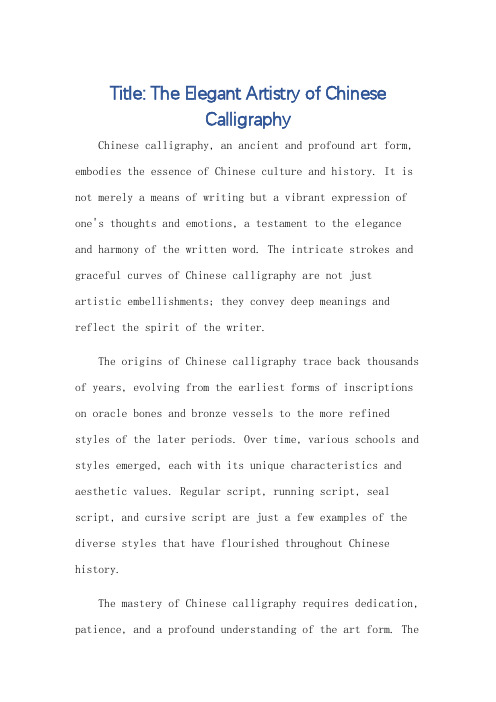
Title: The Elegant Artistry of ChineseCalligraphyChinese calligraphy, an ancient and profound art form, embodies the essence of Chinese culture and history. It is not merely a means of writing but a vibrant expression of one's thoughts and emotions, a testament to the elegance and harmony of the written word. The intricate strokes and graceful curves of Chinese calligraphy are not justartistic embellishments; they convey deep meanings and reflect the spirit of the writer.The origins of Chinese calligraphy trace back thousands of years, evolving from the earliest forms of inscriptions on oracle bones and bronze vessels to the more refined styles of the later periods. Over time, various schools and styles emerged, each with its unique characteristics and aesthetic values. Regular script, running script, seal script, and cursive script are just a few examples of the diverse styles that have flourished throughout Chinese history.The mastery of Chinese calligraphy requires dedication, patience, and a profound understanding of the art form. Theartist must possess a keen eye for balance and proportion, as well as a subtle grasp of the dynamics of brushstroke and ink flow. The choice of brush, ink, and paper is also crucial, as these materials significantly influence the final outcome of the work.One of the most striking aspects of Chinese calligraphy is its ability to convey the writer's personality and mood. The freehand brushstrokes can be bold and dynamic, reflecting a lively and assertive temperament, or they can be delicate and graceful, reflecting a serene and contemplative spirit. In this way, Chinese calligraphy becomes a window into the soul of the artist, a powerful tool for self-expression and communication.Moreover, Chinese calligraphy serves as a bridge between the past and the present, connecting generations of Chinese people through the shared language and cultural heritage. It is a testament to the continuity andresilience of Chinese culture, surviving through centuries of political and social upheaval.In the modern era, Chinese calligraphy remains as vibrant and relevant as ever. It is not only preserved andpracticed by traditional artists but also embraced by a new generation of creatives who are reimagining and reinterpreting this ancient art form. From digital reinterpretations to contemporary art installations, Chinese calligraphy continues to inspire and captivate audiences worldwide.In conclusion, Chinese calligraphy is a rich and multifaceted art form that encapsulates the essence of Chinese culture and history. It is a powerful medium of expression, a testament to the creativity and wisdom of the Chinese people, and a source of inspiration for generations to come.**中国书法的优雅艺术**中国书法,一种古老而深刻的艺术形式,体现了中国文化和历史的精髓。
中国书法介绍(英文)

Regular script
Fame, is based on the regular script calligraphy, cursive script is the best combination of practicality and artistry of the font. So, running from its birth to now, more than 1000 years, and has been popular for centuries. Wang Xizhi's Lanting Ji Xu was known as the best in the running script. Yan Zhenqing's article-nephew of manuscripts, known as the second book in the world. In the art of calligraphy, seal, Li, Kai, grass script, there are certain rules, but the cursive scripts were not necessarily written. Fame is a versatile font, written in script component in some more, commonly known as "Xingkai"; with cursive elements more, commonly known as "free". Fame doesn't follow a set pattern, but share a common characteristic, that is: less writing pen collection Office, Lu feng, hidden front; turn round stroke conversion, less discount.
(完整word)中国书法英文介绍

Good afternoon everyone,Today, our team’s topic is Chinese calligraphy and painting。
First of all, let me introduce the first half of the Chinese calligraphy。
开篇视频翻译:Calligraphy is traditionally been regarded in China as the highest form of visual art.书法,传统上被视为视觉艺术的最高形式。
The four treasures……文房四宝,笔墨纸砚 pine soot(松烟)Calligraphy in social dimension……self-cultivation emulation of moral exemplars书法在社会层面上,孔子:自我修养,效仿道德模范老子:内心自我认识的表达直到今天,中国书法依然在中国人生活中保持着强大力量。
Chinese calligraphy, the four ancient Chinese artistic forms are called qin, chess, penmanship,and painting; and penmanship particularly refers to Chinese calligraphy. (中国古代四大艺术“琴棋书画”的“书”特指书法)Chinese calligraphy is a kind of art using a brush to write seal script, official script, regular script, running script, and cursive script, and other various writing styles of Chinese characters。
2022年介绍中国书法的英语演讲稿_Speech on Chinese Calligraphy 4篇
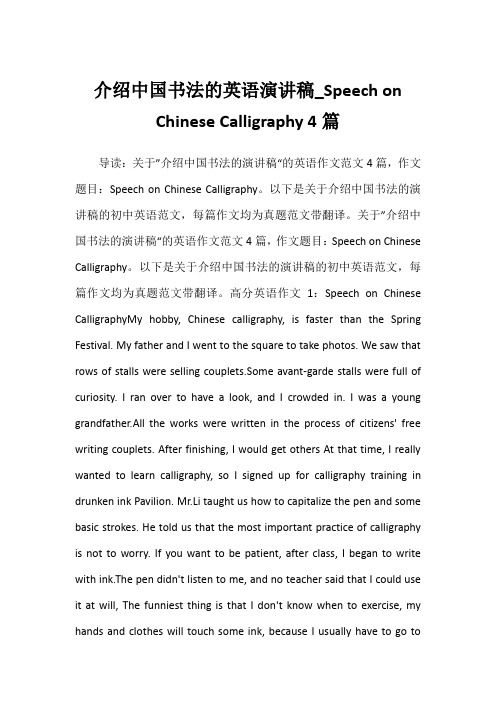
介绍中国书法的英语演讲稿_Speech onChinese Calligraphy 4篇导读:关于”介绍中国书法的演讲稿“的英语作文范文4篇,作文题目:Speech on Chinese Calligraphy。
以下是关于介绍中国书法的演讲稿的初中英语范文,每篇作文均为真题范文带翻译。
关于”介绍中国书法的演讲稿“的英语作文范文4篇,作文题目:Speech on Chinese Calligraphy。
以下是关于介绍中国书法的演讲稿的初中英语范文,每篇作文均为真题范文带翻译。
高分英语作文1:Speech on Chinese CalligraphyMy hobby, Chinese calligraphy, is faster than the Spring Festival. My father and I went to the square to take photos. We saw that rows of stalls were selling couplets.Some avant-garde stalls were full of curiosity. I ran over to have a look, and I crowded in. I was a young grandfather.All the works were written in the process of citizens' free writing couplets. After finishing, I would get others At that time, I really wanted to learn calligraphy, so I signed up for calligraphy training in drunken ink Pavilion. Mr.Li taught us how to capitalize the pen and some basic strokes. He told us that the most important practice of calligraphy is not to worry. If you want to be patient, after class, I began to write with ink.The pen didn't listen to me, and no teacher said that I could use it at will, The funniest thing is that I don't know when to exercise, my hands and clothes will touch some ink, because I usually have to go toschool, and I go to learn calligraphy on Sunday. When I finish my homework, I practice a word with him, mainly to copy Ouyang Xiu's font slowly. My big characters are much better than before.I play games with my father occasionally at home. My father praises me for my good writing, Li The teacher also praised me for my good progress, so I was particularly confident to take a look. At the twelfth word, I had a piece of work, which was Li Bai's "the Lushan watell".It was even more beautiful when I went up the mountain. I hung it in my study. My guests always appreciated my works before and after the Spring Festival.Mr. Li taught us to write Spring Festival couplets. First, learn origami, then cursive script.If you can't say it's good, you should hang it“ "Happiness" is reversed, and I wrote a lot of couplets, hanging "happiness" upside down, for grandma and relatives to listen to, I heard their praise, happy than the prize, get everyone's affirmation, and I am now more interested in calligraphy, more than a year later, whether it is Sunday or holiday, I am actively learning calligraphy, I am looking forward to greater progress, to participate in some writing I believe that I will overcome all difficulties, adhere to the road of calligraphy and become a calligrapher.中文翻译:我的爱好,中国书法记得第xx年,比春节还快,我和爸爸到广场去拍照,看到一排排的摊位都在卖对联,有点前卫的摊位上满是人的好奇心,我跑过去一看,一看就挤了进去,是个年纪不大的爷爷,都是在市民免费写对联的过程中写好的作品,完成后会得到别人的赞梅生当时我真的很想学书法所以我在《醉墨轩》里报名并开始了我的书法训练,教我们如何拿笔和一些基本的笔画大写,告诉我们,最重要的练习书法不用担心,想有耐性下课后,我就蘸着墨水开始写字,钢笔不听我的,也没有老师说可以随意使用它,最可笑的是,锻炼不知道什么时候,我的手和衣服都会碰上一些墨水,因为平时要上学,到了星期天才去学书法家里我做完作业就和他练习了一个字,主要是把欧阳修的字体慢慢地抄出来,我的大字比以前写得好看多了,我在家偶尔和爸爸游戏爸爸夸我写得好,也夸我进步很好,所以我特别有信心转一眼,到第十二个字,我就一幅作品,是李白的《那庐山瀑布在》,上山后更美了,我把它挂在我书房里,来我家的客人总是在春节前后欣赏我的作品,教我们写春联,先是学折纸,然后是草书,说不出好还大挂“幸福”颠倒了,而我写了很多副对联,把“幸福”倒挂,给奶奶和亲戚们听,我听了他们的夸奖,比奖品要快乐得到大家的肯定,而我现在对书法的兴趣更浓厚了,xx年多以后,无论是周日还是假期,我是自己主动学习书法的,我期待着有更大的进步,参加一些写作比赛,已经让妈妈开心快乐奖章我相信我会克服一切困难,坚持走书法这条路,成为一名书法家。
中国书法英文作文
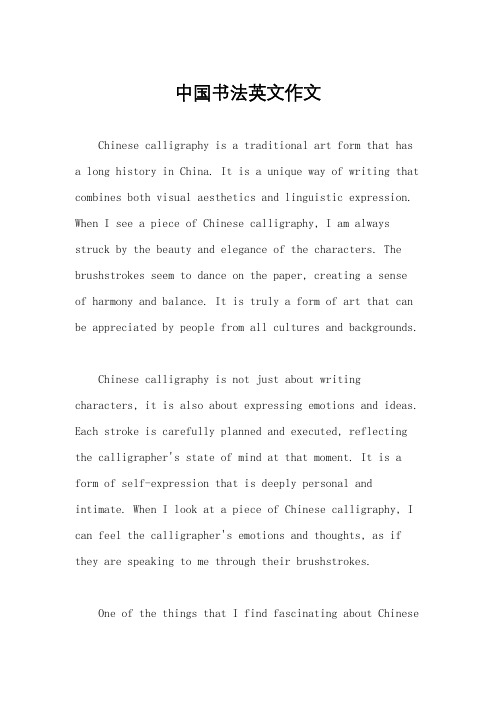
中国书法英文作文Chinese calligraphy is a traditional art form that has a long history in China. It is a unique way of writing that combines both visual aesthetics and linguistic expression. When I see a piece of Chinese calligraphy, I am always struck by the beauty and elegance of the characters. The brushstrokes seem to dance on the paper, creating a sense of harmony and balance. It is truly a form of art that can be appreciated by people from all cultures and backgrounds.Chinese calligraphy is not just about writing characters, it is also about expressing emotions and ideas. Each stroke is carefully planned and executed, reflecting the calligrapher's state of mind at that moment. It is a form of self-expression that is deeply personal and intimate. When I look at a piece of Chinese calligraphy, I can feel the calligrapher's emotions and thoughts, as if they are speaking to me through their brushstrokes.One of the things that I find fascinating about Chinesecalligraphy is the emphasis on rhythm and flow. The brush moves across the paper with a sense of rhythm and grace, creating a visual melody that is both soothing and captivating. It is like a dance between the calligrapher and the brush, a conversation between the artist and the medium. I can almost hear the sound of the brush as it glides across the paper, leaving behind a trail of ink.Chinese calligraphy is also deeply rooted in Chinese culture and history. It is not just a form of art, but a reflection of the Chinese way of life. The characters that are used in calligraphy are not just symbols, but also carry deep cultural and historical meanings. Each stroke is a connection to the past, a link to the rich heritage of China. When I see a piece of Chinese calligraphy, I am reminded of the long and storied history of this ancient civilization.In conclusion, Chinese calligraphy is a beautiful and expressive art form that combines visual aesthetics with linguistic expression. It is a form of self-expression that is deeply personal and intimate. The emphasis on rhythm andflow creates a sense of harmony and balance. Chinese calligraphy is not just a form of art, but also a reflection of Chinese culture and history. It is a unique and fascinating art form that can be appreciated by people from all walks of life.。
中国的非物质文化遗产介绍英文
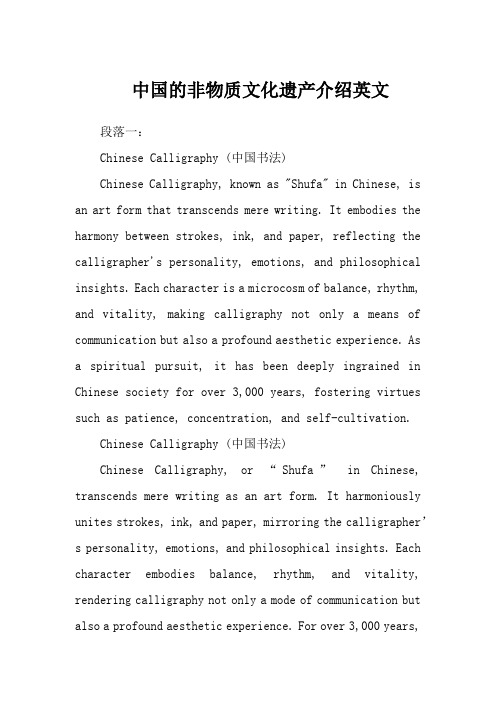
中国的非物质文化遗产介绍英文段落一:Chinese Calligraphy (中国书法)Chinese Calligraphy, known as "Shufa" in Chinese, is an art form that transcends mere writing. It embodies the harmony between strokes, ink, and paper, reflecting the calligrapher's personality, emotions, and philosophical insights. Each character is a microcosm of balance, rhythm, and vitality, making calligraphy not only a means of communication but also a profound aesthetic experience. As a spiritual pursuit, it has been deeply ingrained in Chinese society for over 3,000 years, fostering virtues such as patience, concentration, and self-cultivation.Chinese Calligraphy (中国书法)Chinese Calligraphy, or “Shufa”in Chinese, transcends mere writing as an art form. It harmoniously unites strokes, ink, and paper, mirroring the calligrapher’s personality, emotions, and philosophical insights. Each character embodies balance, rhythm, and vitality, rendering calligraphy not only a mode of communication but also a profound aesthetic experience. For over 3,000 years,it has been deeply rooted in Chinese society as a spiritual pursuit, nurturing virtues like patience, concentration, and self-cultivation.段落二:Peking Opera (京剧)Peking Opera, or "Jingju" in Chinese, is a theatrical spectacle combining singing, recitation, acting, martial arts, and acrobatics. Its distinctive makeup, costumes, and gestures convey complex characters and narratives, often drawn from historical events, myths, and legends. With a history spanning more than 200 years, Peking Opera has evolved into a national symbol, representing the pinnacle of Chinese operatic art. It continues to captivate audiences worldwide with its vivid storytelling, exquisite music, and profound cultural significance.Peking Opera (京剧)Peking Opera, known as “Jingju” in Chinese, is a theatrical extravaganza integrating singing, recitation, acting, martial arts, and acrobatics. Distinctive makeup, costumes, and gestures convey intricate characters and narratives, often derived from historical events, myths, and legends. Over 200 years old, Peking Opera has becomea national emblem, embodying the apex of Chinese operatic art. It enthralls global audiences with its vivid storytelling, sublime music, and profound cultural import.段落三:Dragon Boat Festival (端午节)The Dragon Boat Festival, or "Duanwu Jie" in Chinese, is a time-honored celebration held annually on the fifth day of the fifth lunar month. It commemorates the ancient poet Qu Yuan and his unwavering loyalty to his country. The festival is marked by vibrant dragon boat races, where teams paddle furiously to the beat of drums, symbolizing attempts to rescue Qu Yuan from the river. Additionally, Zongzi –glutinous rice dumplings wrapped in bamboo leaves –are enjoyed as a traditional delicacy. This festive occasion encapsulates China's respect for history, reverence for ancestors, and commitment to preserving cultural heritage.Dragon Boat Festival (端午节)The Dragon Boat Festival, or “Duanwu Jie” in Chinese, is an age-old celebration observed annually on the fifth day of the fifth lunar month. It honors the ancient poet Qu Yuan and his steadfast devotion to his homeland.Characterized by energetic dragon boat races, where teams paddle in sync with drumbeats, symbolizing efforts to save Qu Yuan from the river, the festival also features Zongzi —glutinous rice dumplings wrapped in bamboo leaves—as a traditional treat. This jubilant event exemplifies China’s respect for history, veneration of ancestors, and dedication to cultural preservation.段落四:Paper-cutting (剪纸)Paper-cutting, or "Jianzhi" in Chinese, is a delicate folk art that dates back to the 6th century. Artists use scissors or knives to intricately cut patterns and images on red paper, symbolizing good fortune and happiness. These vibrant creations, often depicting auspicious symbols, flora, fauna, or scenes from daily life, adorn windows, doors, and walls during festivals or special occasions. Paper-cutting reflects the Chinese people's appreciation for beauty, symmetry, and symbolism, as well as their ability to transform simple materials into extraordinary expressions of cultural identity.Paper-cutting (剪纸)Paper-cutting, or “Jianzhi” in Chinese, is a refinedfolk art with roots dating back to the 6th century. Using scissors or knives, artists skillfully cut intricate patterns and images onto red paper, signifying good luck and joy. Vibrant designs, frequently portraying auspicious symbols, plants, animals, or everyday scenes, embellish windows, doors, and walls during festivals or special events. This artform mirrors the Chinese populace’s admiration for beauty, symmetry, and symbolism, as well as their talent for transforming humble materials into extraordinary manifestations of cultural identity.In conclusion, China's intangible cultural heritage is a treasure trove of artistic expression, historical narrative, and communal spirit. From the graceful lines of calligraphy to the dramatic spectacle of Peking Opera, from the festive traditions of the Dragon Boat Festival to the intricate charm of paper-cutting, each element contributes to the rich tapestry of Chinese culture. These living legacies continue to thrive, evolve, and inspire, serving as vital links to the past while enriching the present and future of Chinese society and humanity at large.总结China's intangible cultural heritage is a wealth ofartistic expression, historical narrative, and communal spirit. Spanning from the elegant strokes of calligraphy to the theatrical grandeur of Peking Opera, from the festive customs of the Dragon Boat Festival to the delicate allure of paper-cutting, each facet adds to the diverse fabric of Chinese culture. These dynamic traditions persist, adapt, and motivate, functioning as crucial connections to the past while enhancing the present and future of both Chinese society and humanity writ large.。
介绍中国书法英语作文
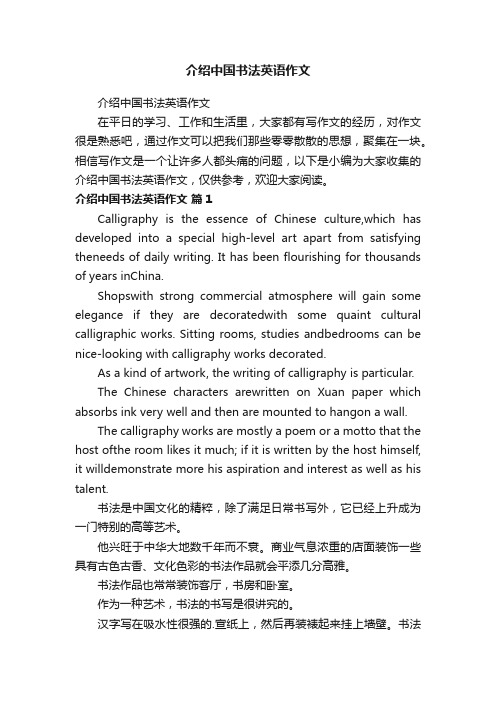
介绍中国书法英语作文介绍中国书法英语作文在平日的学习、工作和生活里,大家都有写作文的经历,对作文很是熟悉吧,通过作文可以把我们那些零零散散的思想,聚集在一块。
相信写作文是一个让许多人都头痛的问题,以下是小编为大家收集的介绍中国书法英语作文,仅供参考,欢迎大家阅读。
介绍中国书法英语作文篇1Calligraphy is the essence of Chinese culture,which has developed into a special high-level art apart from satisfying theneeds of daily writing. It has been flourishing for thousands of years inChina.Shopswith strong commercial atmosphere will gain some elegance if they are decoratedwith some quaint cultural calligraphic works. Sitting rooms, studies andbedrooms can be nice-looking with calligraphy works decorated.As a kind of artwork, the writing of calligraphy is particular.The Chinese characters arewritten on Xuan paper which absorbs ink very well and then are mounted to hangon a wall.The calligraphy works are mostly a poem or a motto that the host ofthe room likes it much; if it is written by the host himself, it willdemonstrate more his aspiration and interest as well as his talent.书法是中国文化的精粹,除了满足日常书写外,它已经上升成为一门特别的高等艺术。
【51Talk-英文介绍中国非遗文库】中国非物质文化遗产:书法
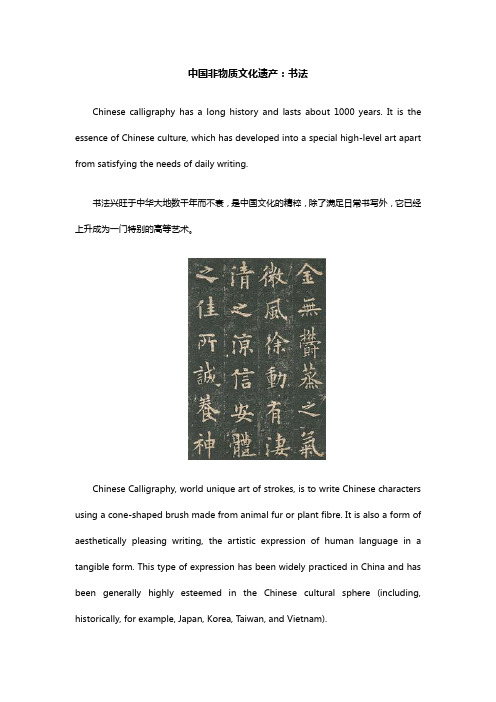
中国非物质文化遗产:书法Chinese calligraphy has a long history and lasts about 1000 years. It is the essence of Chinese culture, which has developed into a special high-level art apart from satisfying the needs of daily writing.书法兴旺于中华大地数千年而不衰,是中国文化的精粹,除了满足日常书写外,它已经上升成为一门特别的高等艺术。
Chinese Calligraphy, world unique art of strokes, is to write Chinese characters using a cone-shaped brush made from animal fur or plant fibre. It is also a form of aesthetically pleasing writing, the artistic expression of human language in a tangible form. This type of expression has been widely practiced in China and has been generally highly esteemed in the Chinese cultural sphere (including, historically, for example, Japan, Korea, T aiwan, and Vietnam).中国书法是用动物或植物纤维等制成的圆锥形毛笔,按照中国书法的书写法则来书写汉字的线条艺术,在世界艺术中独一无二。
它也是一种审美愉悦的书写形式,是人类语言以有形形式的艺术表达。
(完整word版)中国书法介绍(英文版)CalligraphyIntroduction
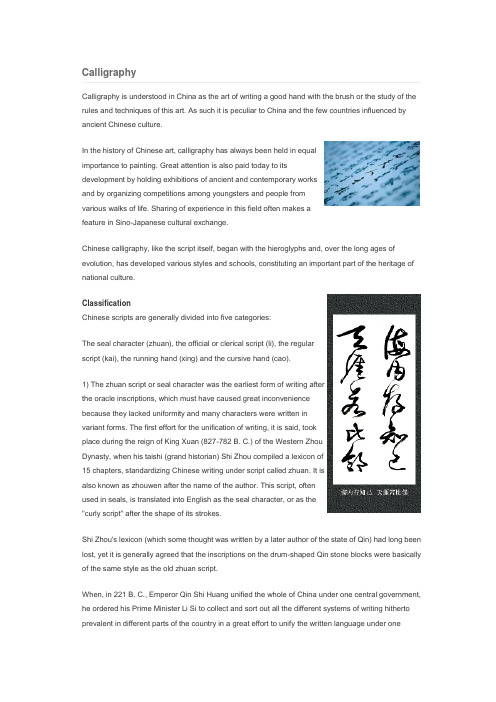
CalligraphyCalligraphy is understood in China as the art of writing a good hand with the brush or the study of the rules and techniques of this art. As such it is peculiar to China and the few countries influenced by ancient Chinese culture.In the history of Chinese art, calligraphy has always been held in equalimportance to painting. Great attention is also paid today to itsdevelopment by holding exhibitions of ancient and contemporary worksand by organizing competitions among youngsters and people fromvarious walks of life. Sharing of experience in this field often makes afeature in Sino-Japanese cultural exchange.Chinese calligraphy, like the script itself, began with the hieroglyphs and, over the long ages of evolution, has developed various styles and schools, constituting an important part of the heritage of national culture.ClassificationChinese scripts are generally divided into five categories:The seal character (zhuan), the official or clerical script (li), the regularscript (kai), the running hand (xing) and the cursive hand (cao).1) The zhuan script or seal character was the earliest form of writing afterthe oracle inscriptions, which must have caused great inconveniencebecause they lacked uniformity and many characters were written invariant forms. The first effort for the unification of writing, it is said, tookplace during the reign of King Xuan (827-782 B. C.) of the Western ZhouDynasty, when his taishi (grand historian) Shi Zhou compiled a lexicon of15 chapters, standardizing Chinese writing under script called zhuan. It isalso known as zhouwen after the name of the author. This script, oftenused in seals, is translated into English as the seal character, or as the"curly script" after the shape of its strokes.Shi Zhou's lexicon (which some thought was written by a later author of the state of Qin) had long been lost, yet it is generally agreed that the inscriptions on the drum-shaped Qin stone blocks were basically of the same style as the old zhuan script.When, in 221 B. C., Emperor Qin Shi Huang unified the whole of China under one central government, he ordered his Prime Minister Li Si to collect and sort out all the different systems of writing hitherto prevalent in different parts of the country in a great effort to unify the written language under onesystem. What Li did, in effect, was to simplify the ancient zhuan (small seal) script.Today we have a most valuable relic of this ancient writing in the creator Li Si's own hand engraved on a stele standing in the Temple to the God of Taishan Mountain in Shandong Province. The2,200-year-old stele, worn by age and weather, has only nine and a half characters left on it.2) The lishu (official script) came in the wake of the xiaozhuan in the same short-lived Qin Dynasty (221 - 207 B. C.). This was because the xiaozhuan, though a simplified form of script, was still too complicated for the scribes in the various government offices who had to copy an increasing amount of documents. Cheng Miao, a prison warden, made a further simplification of the xiaozhuan, changing the curly strokes into straight and angular ones and thus making writing much easier. A further step away from the pictographs, it was named lishu because li in classical Chinese meant "clerk" or "scribe". Another version says that Cheng Miao, because of certain offence, became a prisoner and slave himself; as the ancients also called bound slaves "li", so the script was named lishu or the "script of a slave".3) The lishu was already very close to, and led to the adoption of, kaishu, regular script. The oldest existing example of this dates from the Wei (220-265), and the script developed under the Jin(265-420). The standard writing today is square in form, non-cursive and architectural in style. The characters are composed of a number of strokes out of a total of eight kinds-the dot, the horizontal, the vertical, the hook, the rising, the left-falling (short and long) and the right-falling strokes. Any aspirant for the status of calligrapher must start by learning to write a good hand in kaishu.4) On the basis of lishu also evolved caoshu (grass writing or cursive hand), which is rapid and used for making quick but rough copies. This style is subdivided into two schools: zhangcao and jincao.The first of these emerged at the time the Qin was replaced by the Han Dynasty between the 3rd and 2nd centuries B. C. The characters, though written rapidly, still stand separate one from another and the dots are not linked up with other strokes.Jincao or the modern cursive hand is said to have been developed by Zhang Zhi (?-c. 192 A. D.) of the Eastern Han Dynasty, flourished in the Jin and Tang dynasties and is still widely popular today.It is the essence of the caoshu, especially jincao, that the characters are executed swiftly with the strokes running together. The characters are often joined up, with the last stroke of the first merging into the initial stroke of the next. They also vary in size in the same piece of writing, all seemingly dictated by the whims of the writer.A great master at caoshu was Zhang Xu (early 8th century) of the Tang Dynasty, noted for the complete abandon with which he applied the brush. It is said that he would not set about writing until he had got drunk. This he did, allowing the brush to "gallop" across the paper, curling, twisting ormeandering in one unbroken stroke, thus creating an original style. Today one may still see fragments of a stele carved with characters in his handwriting, kept in the Provincial Museum of Shaanxi.The best example and model for xingshu, all Chinese calligraphers will agree, is the Inscription on Lanting Pavilion in the hand of Wang Xizhi (321-379) of the Eastern Jin Dynasty. To learn to write a nice hand in Chinese calligraphy, assiduous and persevering practice is necessary. This has been borne out by the many great masters China has produced. Wang Xizhi, the great artist just mentioned, who has exerted a profound influence on, and has been held in high esteem by, calligraphers and scholars throughout history, is said to have blackened in his childhood all the water of a pond in front of his house by washing the writing implements in it after his daily exercises. Another master, Monk Zhiyong of the Sui Dynasty (581-618) was so industrious in learning calligraphy that he filled many jars with worn-out writing brushes, which he buried in a "tomb of brushes".Renewed interest in brush-writing has been kindled today among the pupils in China, some of whom already show promises as worthy successors to the ancient masters.Four Treasures of the StudyTo produce Chinese characters one will need a brush, paper, inkstick and ink stone, commonly referred to as the "Four Treasures ofthe Study". To learn calligraphy, it is necessary to learn about thesetools.While brushes are varied, white-goat-hair, black-rabbit-hair and yellow-weasel-hair brushes are the main ones. On the basis of function, brushes are classified into three groups: hard, soft and both. Brush handles are usually made of bamboo, wood, lacquer or porcelain; ivory or jade handles are rare and precious.The ink stick is a unique pigment used for Chinese traditional painting and calligraphy. The most famous ink stick ishui mo(Anhui ink stick), made of pines that grow on Huangshan Mountain in Anhui Province. Clean water is needed to grind the ink stick, which must be balanced in the hand during the grinding or rubbing process. Press hard and rub lightly, slowly and evenly against the ink slab until a thick, liquid-ink forms.Paper was invented by Cai Lun in the Eastern Han Dynasty (25-220). While paper comes in many varieties, Xuan paper, produced in the Jing Prefecture of Xuanzhou (today's Anhui Province), is considered the best for Chinese calligraphy. The paper is soft and fine textured, suitable for conveying the artistic expression of both Chinese calligraphy and painting. With a good tensile strength and mothproof quality, the paper can be preserved for a long time.Ink stones or ink slabs have been classified into three categories:Duan,SheandTao. Features common to all three ink slabs are the stone's hardness and fineness. Although the stone is hard and fine, it is notdry or slippery. Using a hard, smooth stone, liquid ink can be produced easily by rubbing the ink stick against the stone.By controlling the flexibility of the brush, the concentration of the ink and the absorbency of the paper, the artist can produce an infinite variety of calligraphic styles and forms.Calligraphy: Leader of All Art FormsFew nations in the world have calligraphy as a form of art. In China, calligraphy has maintained a close rapport with the country's cultural development.Calligraphy is an expressive art. According to an old Chinese saying, "the way characters are written is a portrait of the person who writes them." Expressing the abstract beauty of lines and rhythms, calligraphy is a reflection of a person's emotions, moral integrity, character, educational level, accomplishments in self-cultivation, intellectual tastes and approach to life. Chinese characters, which convey ideas, are regarded as the most abstract and sublime art form.Calligraphy is also a practical fine art. Exotic calligraphic inscriptions written on paper, wooden plaques or stone tablets serve as decorations of a deep artistic value.Calligraphy manifests the basic characteristics of all Chinese arts. Closely associated with paintings -- the two leaders of Chinese art forms -- calligraphy takes precedence over painting since it greatly inspired the art of painting. Moreover, calligraphy has influenced other typically Chinese art forms like classical poetry, seal-cutting, sculpture, traditional music and dance, architecture and handicrafts.Calligraphy is a mental exercise that coordinates the mind and body. It is a most relaxing yet highly disciplined exercise for physical and spiritual well-being. Historically, many calligraphic artists lived to a ripe, old age.An Art of the OrientChinese calligraphy is an Oriental art. Like chopsticks, calligraphy was once entirely Chinese, but as Chinese culture spread to Korea, Japan, and Singapore, calligraphy became a unique feature of the Oriental art.Calligraphy is even wildly accepted by the West; as once Picasso said, "Had I been born Chinese, I would have been a calligrapher, not a painter." Many calligraphic elements are being adopted by modern western art.。
书法介绍(英文版)CalligraphyIntroduction

CalligraphyCalligraphy is understood in China as the art of writing a good hand with the brush or the study of the rules and techniques of this art. As such it is peculiar to China and the few countries influenced by ancient Chinese culture.In the history of Chinese art, calligraphy has always been held in equalimportance to painting. Great attention is also paid today to itsdevelopment by holding exhibitions of ancient and contemporary worksand by organizing competitions among youngsters and people fromvarious walks of life. Sharing of experience in this field often makes afeature in Sino-Japanese cultural exchange.Chinese calligraphy, like the script itself, began with the hieroglyphs and, over the long ages of evolution, has developed various styles and schools, constituting an important part of the heritage of national culture.ClassificationChinese scripts are generally divided into five categories:The seal character (zhuan), the official or clerical script (li), the regularscript (kai), the running hand (xing) and the cursive hand (cao).1) The zhuan script or seal character was the earliest form of writing afterthe oracle inscriptions, which must have caused great inconveniencebecause they lacked uniformity and many characters were written invariant forms. The first effort for the unification of writing, it is said, tookplace during the reign of King Xuan (827-782 B. C.) of the Western ZhouDynasty, when his taishi (grand historian) Shi Zhou compiled a lexicon of15 chapters, standardizing Chinese writing under script called zhuan. It isalso known as zhouwen after the name of the author. This script, oftenused in seals, is translated into English as the seal character, or as the"curly script" after the shape of its strokes.Shi Zhou's lexicon (which some thought was written by a later author of the state of Qin) had long been lost, yet it is generally agreed that the inscriptions on the drum-shaped Qin stone blocks were basically of the same style as the old zhuan script.When, in 221 B. C., Emperor Qin Shi Huang unified the whole of China under one central government, he ordered his Prime Minister Li Si to collect and sort out all the different systems of writing hitherto prevalent in different parts of the country in a great effort to unify the written language under onesystem. What Li did, in effect, was to simplify the ancient zhuan (small seal) script.Today we have a most valuable relic of this ancient writing in the creator Li Si's own hand engraved on a stele standing in the Temple to the God of Taishan Mountain in Shandong Province. The2,200-year-old stele, worn by age and weather, has only nine and a half characters left on it.2) The lishu (official script) came in the wake of the xiaozhuan in the same short-lived Qin Dynasty (221 - 207 B. C.). This was because the xiaozhuan, though a simplified form of script, was still too complicated for the scribes in the various government offices who had to copy an increasing amount of documents. Cheng Miao, a prison warden, made a further simplification of the xiaozhuan, changing the curly strokes into straight and angular ones and thus making writing much easier. A further step away from the pictographs, it was named lishu because li in classical Chinese meant "clerk" or "scribe". Another version says that Cheng Miao, because of certain offence, became a prisoner and slave himself; as the ancients also called bound slaves "li", so the script was named lishu or the "script of a slave".3) The lishu was already very close to, and led to the adoption of, kaishu, regular script. The oldest existing example of this dates from the Wei (220-265), and the script developed under the Jin(265-420). The standard writing today is square in form, non-cursive and architectural in style. The characters are composed of a number of strokes out of a total of eight kinds-the dot, the horizontal, the vertical, the hook, the rising, the left-falling (short and long) and the right-falling strokes. Any aspirant for the status of calligrapher must start by learning to write a good hand in kaishu.4) On the basis of lishu also evolved caoshu (grass writing or cursive hand), which is rapid and used for making quick but rough copies. This style is subdivided into two schools: zhangcao and jincao.The first of these emerged at the time the Qin was replaced by the Han Dynasty between the 3rd and 2nd centuries B. C. The characters, though written rapidly, still stand separate one from another and the dots are not linked up with other strokes.Jincao or the modern cursive hand is said to have been developed by Zhang Zhi (?-c. 192 A. D.) of the Eastern Han Dynasty, flourished in the Jin and Tang dynasties and is still widely popular today.It is the essence of the caoshu, especially jincao, that the characters are executed swiftly with the strokes running together. The characters are often joined up, with the last stroke of the first merging into the initial stroke of the next. They also vary in size in the same piece of writing, all seemingly dictated by the whims of the writer.A great master at caoshu was Zhang Xu (early 8th century) of the Tang Dynasty, noted for the complete abandon with which he applied the brush. It is said that he would not set about writing until he had got drunk. This he did, allowing the brush to "gallop" across the paper, curling, twisting ormeandering in one unbroken stroke, thus creating an original style. Today one may still see fragments of a stele carved with characters in his handwriting, kept in the Provincial Museum of Shaanxi.The best example and model for xingshu, all Chinese calligraphers will agree, is the Inscription on Lanting Pavilion in the hand of Wang Xizhi (321-379) of the Eastern Jin Dynasty. To learn to write a nice hand in Chinese calligraphy, assiduous and persevering practice is necessary. This has been borne out by the many great masters China has produced. Wang Xizhi, the great artist just mentioned, who has exerted a profound influence on, and has been held in high esteem by, calligraphers and scholars throughout history, is said to have blackened in his childhood all the water of a pond in front of his house by washing the writing implements in it after his daily exercises. Another master, Monk Zhiyong of the Sui Dynasty (581-618) was so industrious in learning calligraphy that he filled many jars with worn-out writing brushes, which he buried in a "tomb of brushes".Renewed interest in brush-writing has been kindled today among the pupils in China, some of whom already show promises as worthy successors to the ancient masters.Four Treasures of the StudyTo produce Chinese characters one will need a brush, paper, inkstick and ink stone, commonly referred to as the "Four Treasures ofthe Study". To learn calligraphy, it is necessary to learn about thesetools.While brushes are varied, white-goat-hair, black-rabbit-hair and yellow-weasel-hair brushes are the main ones. On the basis of function, brushes are classified into three groups: hard, soft and both. Brush handles are usually made of bamboo, wood, lacquer or porcelain; ivory or jade handles are rare and precious.The ink stick is a unique pigment used for Chinese traditional painting and calligraphy. The most famous ink stick ishui mo(Anhui ink stick), made of pines that grow on Huangshan Mountain in Anhui Province. Clean water is needed to grind the ink stick, which must be balanced in the hand during the grinding or rubbing process. Press hard and rub lightly, slowly and evenly against the ink slab until a thick, liquid-ink forms.Paper was invented by Cai Lun in the Eastern Han Dynasty (25-220). While paper comes in many varieties, Xuan paper, produced in the Jing Prefecture of Xuanzhou (today's Anhui Province), is considered the best for Chinese calligraphy. The paper is soft and fine textured, suitable for conveying the artistic expression of both Chinese calligraphy and painting. With a good tensile strength and mothproof quality, the paper can be preserved for a long time.Ink stones or ink slabs have been classified into three categories:Duan,SheandTao. Features common to all three ink slabs are the stone's hardness and fineness. Although the stone is hard and fine, it is notdry or slippery. Using a hard, smooth stone, liquid ink can be produced easily by rubbing the ink stick against the stone.By controlling the flexibility of the brush, the concentration of the ink and the absorbency of the paper, the artist can produce an infinite variety of calligraphic styles and forms.Calligraphy: Leader of All Art FormsFew nations in the world have calligraphy as a form of art. In China, calligraphy has maintained a close rapport with the country's cultural development.Calligraphy is an expressive art. According to an old Chinese saying, "the way characters are written is a portrait of the person who writes them." Expressing the abstract beauty of lines and rhythms, calligraphy is a reflection of a person's emotions, moral integrity, character, educational level, accomplishments in self-cultivation, intellectual tastes and approach to life. Chinese characters, which convey ideas, are regarded as the most abstract and sublime art form.Calligraphy is also a practical fine art. Exotic calligraphic inscriptions written on paper, wooden plaques or stone tablets serve as decorations of a deep artistic value.Calligraphy manifests the basic characteristics of all Chinese arts. Closely associated with paintings -- the two leaders of Chinese art forms -- calligraphy takes precedence over painting since it greatly inspired the art of painting. Moreover, calligraphy has influenced other typically Chinese art forms like classical poetry, seal-cutting, sculpture, traditional music and dance, architecture and handicrafts.Calligraphy is a mental exercise that coordinates the mind and body. It is a most relaxing yet highly disciplined exercise for physical and spiritual well-being. Historically, many calligraphic artists lived to a ripe, old age.An Art of the OrientChinese calligraphy is an Oriental art. Like chopsticks, calligraphy was once entirely Chinese, but as Chinese culture spread to Korea, Japan, and Singapore, calligraphy became a unique feature of the Oriental art.Calligraphy is even wildly accepted by the West; as once Picasso said, "Had I been born Chinese, I would have been a calligrapher, not a painter." Many calligraphic elements are being adopted by modern western art.。
中国书法英语作文带翻译
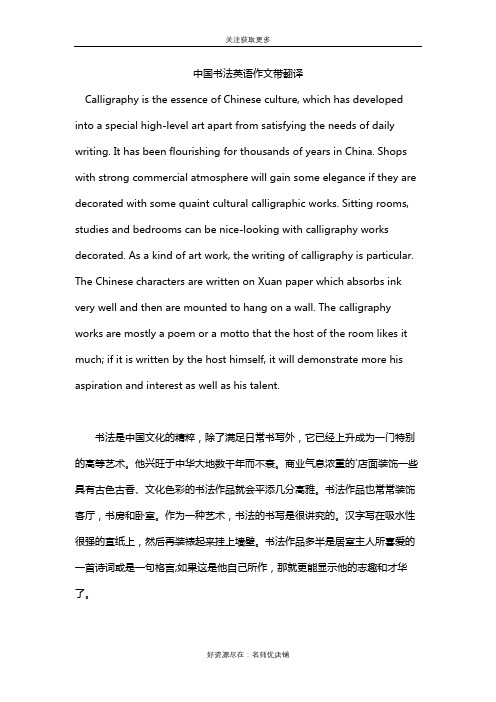
关注获取更多中国书法英语作文带翻译Calligraphy is the essence of Chinese culture, which has developed into a special high-level art apart from satisfying the needs of daily writing. It has been flourishing for thousands of years in China. Shops with strong commercial atmosphere will gain some elegance if they are decorated with some quaint cultural calligraphic works. Sitting rooms, studies and bedrooms can be nice-looking with calligraphy works decorated. As a kind of art work, the writing of calligraphy is particular. The Chinese characters are written on Xuan paper which absorbs ink very well and then are mounted to hang on a wall. The calligraphy works are mostly a poem or a motto that the host of the room likes it much; if it is written by the host himself, it will demonstrate more his aspiration and interest as well as his talent.书法是中国文化的精粹,除了满足日常书写外,它已经上升成为一门特别的高等艺术。
书法传统英语作文模板
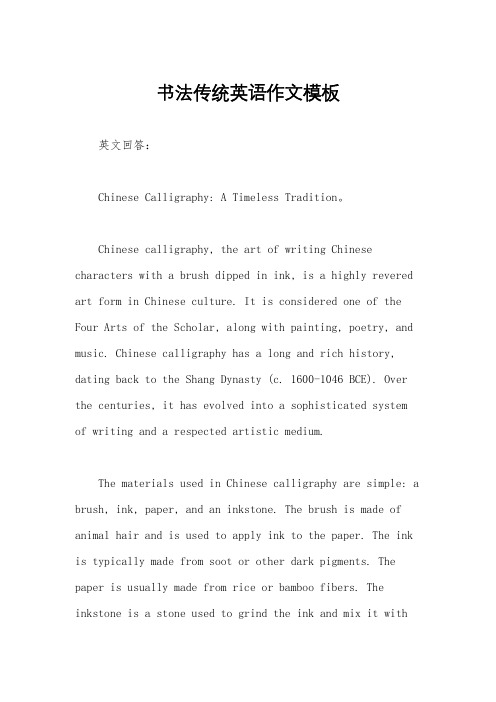
书法传统英语作文模板英文回答:Chinese Calligraphy: A Timeless Tradition。
Chinese calligraphy, the art of writing Chinese characters with a brush dipped in ink, is a highly revered art form in Chinese culture. It is considered one of the Four Arts of the Scholar, along with painting, poetry, and music. Chinese calligraphy has a long and rich history, dating back to the Shang Dynasty (c. 1600-1046 BCE). Over the centuries, it has evolved into a sophisticated system of writing and a respected artistic medium.The materials used in Chinese calligraphy are simple: a brush, ink, paper, and an inkstone. The brush is made of animal hair and is used to apply ink to the paper. The ink is typically made from soot or other dark pigments. The paper is usually made from rice or bamboo fibers. The inkstone is a stone used to grind the ink and mix it withwater.Chinese calligraphy is characterized by its flowing lines, subtle gradations of thickness and thinness, and balanced composition. The characters themselves are often highly stylized and can vary greatly in size and shape. Chinese calligraphers often strive to achieve a sense of harmony and elegance in their work.There are many different styles of Chinese calligraphy, each with its unique characteristics. Some of the mostwell-known styles include:Seal script: The oldest style of Chinese calligraphy, dating back to the Shang Dynasty. It is characterized byits simple, angular characters.Clerical script: A more formal style of calligraphy that was used for official documents. It is characterized by its square, regular characters.Regular script: A standardized style of calligraphythat was developed during the Han Dynasty (206 BCE-220 CE). It is characterized by its clear, legible characters.Semi-cursive script: A less formal style ofcalligraphy that is characterized by its flowing, connected characters.Cursive script: The most informal style of calligraphy, characterized by its rapid, flowing strokes.Chinese calligraphy is used for a variety of purposes, including writing, painting, and decoration. It is often used to create works of art, such as scrolls, fans, and album leaves. Calligraphy is also used for practical purposes, such as writing letters, poems, and essays.Chinese calligraphy is a highly respected art form in Chinese culture. It is considered a mark of intelligenceand refinement. Calligraphers are often held in high esteem and their work is often collected and displayed in museums and galleries.中文回答:书法,一项历久弥新的传统。
中国书法(英文版)简介
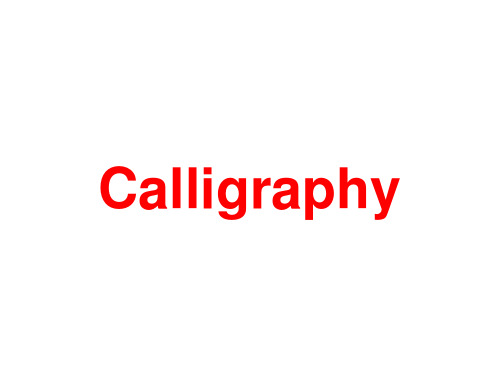
• Su Shi,Huang Tingjian, etc.
• Ming and Qing Dynasties
• Calligraphy in China made great progress again——the art of painting flourished in Ming Dynasty and gave impetus to the development of it
• Modern Times
• Writing instruments: pen, pencil, ballpen • Chinese calligraphy lost its value of practical use and gradually became a pure artistic form • Decorative calligraphy can be found everywhere, especially in temples and pagodas, on the walls of caves, and the sides of mountains and monuments
• Eastern Han Caoshu(草书) • With strokes flowing and characters linking together • The style looks more smooth and lively • Xingshu(行书) Eastern Han • Write in a simpler and faster way
• Eastern Jin Dynasty
• Wang XiZhi :developed a new style of his own and reached a very level of artistic achievement in the running and cursive hand. • Was respected as the “master of calligraphy”. • His handwriting influenced many later calligrphy.
英文介绍中国书法好处作文
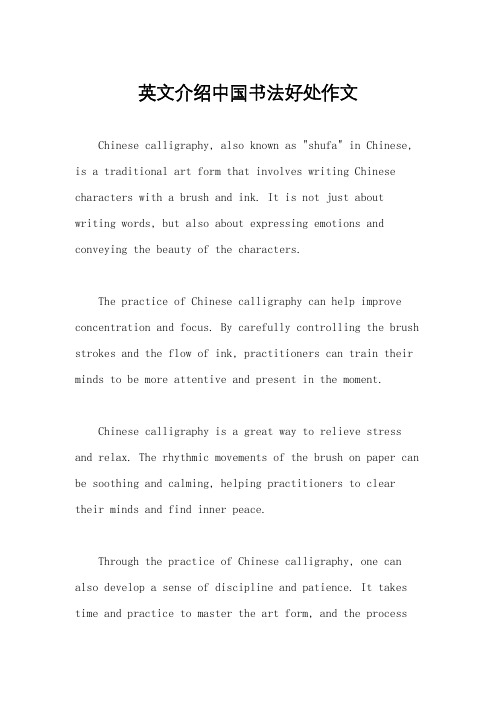
英文介绍中国书法好处作文Chinese calligraphy, also known as "shufa" in Chinese, is a traditional art form that involves writing Chinese characters with a brush and ink. It is not just about writing words, but also about expressing emotions and conveying the beauty of the characters.The practice of Chinese calligraphy can help improve concentration and focus. By carefully controlling the brush strokes and the flow of ink, practitioners can train their minds to be more attentive and present in the moment.Chinese calligraphy is a great way to relieve stress and relax. The rhythmic movements of the brush on paper can be soothing and calming, helping practitioners to clear their minds and find inner peace.Through the practice of Chinese calligraphy, one can also develop a sense of discipline and patience. It takes time and practice to master the art form, and the processof learning can teach valuable lessons in perseverance and dedication.Chinese calligraphy can also be a form of self-expression and creativity. Each practitioner has their own unique style and interpretation of the characters, allowing for personal expression and artistic exploration.In addition, Chinese calligraphy is a cultural treasure that carries with it thousands of years of history and tradition. By practicing this art form, one can connect with the rich cultural heritage of China and appreciate the beauty of the written language.。
书法传统文化英语作文100字
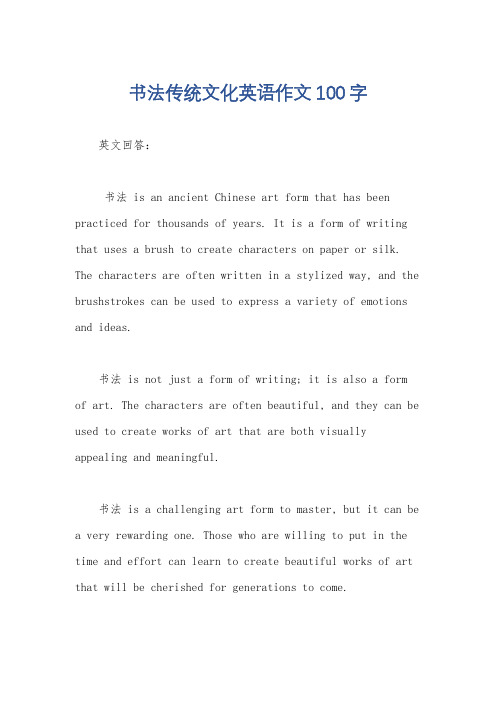
书法传统文化英语作文100字英文回答:书法 is an ancient Chinese art form that has been practiced for thousands of years. It is a form of writing that uses a brush to create characters on paper or silk. The characters are often written in a stylized way, and the brushstrokes can be used to express a variety of emotions and ideas.书法 is not just a form of writing; it is also a form of art. The characters are often beautiful, and they can be used to create works of art that are both visually appealing and meaningful.书法 is a challenging art form to master, but it can be a very rewarding one. Those who are willing to put in the time and effort can learn to create beautiful works of art that will be cherished for generations to come.中文回答:书法是中国古代的一种艺术形式,已有数千年的历史。
它是一种用笔墨、宣纸或绢帛创作汉字的艺术,汉字通常会采用独特而精巧的书写方式,笔画也能够表达出各种各样的情感和思想。
书法不仅仅是一种书写方式,它更是一种艺术形式。
- 1、下载文档前请自行甄别文档内容的完整性,平台不提供额外的编辑、内容补充、找答案等附加服务。
- 2、"仅部分预览"的文档,不可在线预览部分如存在完整性等问题,可反馈申请退款(可完整预览的文档不适用该条件!)。
- 3、如文档侵犯您的权益,请联系客服反馈,我们会尽快为您处理(人工客服工作时间:9:00-18:30)。
Cursive script
Cursive
script has more flexibility, for it only maintains the essence of each character and expresses more personal exertion. Therefore its value lies in appreciation more than practicality.
Categories: Chinese traditional calligraphy mainly falls into 4 categories: Seal Script, Official Script. Regular Script and Cursive Script.
seal script
Ink
Slab The ink slab is the reputed head of the ‘four treasures’, for its sobriety(持重) and elegance (典雅)has endured the passage of time. Through ink slabs, people can sample the artistic charm(魅力) of sculpting(雕塑) and the ink stone's natural tints.
Paper Paper making is among the ‘four great inventions’ and one of the great contributions that ancient Chinese people made to the word.It was Cai Lun who made the valuable contribution and his research gave rise to paper. Afterwards, many varieties of paper were produced of different quality and usage(使用). Today the Xuan paper originally made in Anhui Province still shines with its charm.
Calligraphy 书法 Calligraphers 书法家 Seal script 篆书 Official script 隶书 Regular script 楷书 Cursive script 草书
Writing brush 毛笔 Ink stick 墨 Paper 纸 Ink slab 砚
Ink
Stick A good ink stick should be ground so as to be refined black with luster(光泽). With the invention of paper, they were improved accordingly. Since the Han Dynasty (206 BC - 220), ink sticks have been made from pine soot(松烟墨), using other procedures(程 序) that include mixing with glue, steaming and molding.
Introduction
Categories
Tools
Introduction:
Calligraphy is considered as a treasured artistic form of Chinese culture. It is not merely a practical technique for writing Chinese characters or a tool for written communication, but also, more importantly, a unique expression of the spiritual world of the calligrapher.
This
was the first example– known as 'seal script' .Calligraphers of seal character stress a slender font, even speed and strength, and even thick lines and strokes. When seen as a whole, this is quite round and contracted.
Tools:
The ink stick, ink slab, writing brush and paper are the four essential implements of calligraphy. They are known together as the Four Treasures of the Study.
official script
In
the Eastern Han Dynasty (25 - 220), people tended to simplify the seal character which had many strokes and created the official script. The new calligraphy appeared to be much neater and delicate(精美的), turning the round style into a flat one.
Today, although various modern ways have been substituted for the original calligraphy, especially which created with a writing brush, people still love the ancient form and practise it untiringly.
Writing Brush The earliest writing brush that has been found is a relic(纪念物) of the Warring States Period (476 BC – 221 BC). From that time on wards, the brush has evolved(进化) into many forms. The nib can be made from rabbit's hair, wool, horsehair, weasel's hair, or bristles, and so on; while the shaft may be made from bamboo, ivory, jade, crystal, gold, silver, porcelain, sandal, etc.
regular script
Just
as the name implies, the regular script features its regularity and varies from the flat font to a square one. In Chinese it provides a model that can be followed by calligraphy lovers. It has developed since the late Han Dynasty and is today's most popular and influential writing style.
